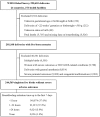Prevalence of early initiation of breastfeeding and determinants of delayed initiation of breastfeeding: secondary analysis of the WHO Global Survey
- PMID: 28322265
- PMCID: PMC5359598
- DOI: 10.1038/srep44868
Prevalence of early initiation of breastfeeding and determinants of delayed initiation of breastfeeding: secondary analysis of the WHO Global Survey
Abstract
Early initiation of breastfeeding (EIBF) within 1 hour of birth can decrease neonatal death. However, the prevalence of EIBF is approximately 50% in many developing countries, and data remains unavailable for some countries. We conducted a secondary analysis using the WHO Global Survey on Maternal and Perinatal Health to identify factors hampering EIBF. We described the coverage of EIBF among 373 health facilities for singleton neonates for whom breastfeeding was initiated after birth. Maternal and facility characteristics of EIBF were compared to those of breastfeeding >1 hour after birth, and multiple logistic regression analysis was performed. In total, 244,569 singleton live births without severe adverse outcomes were analysed. The EIBF prevalence varied widely among countries and ranged from 17.7% to 98.4% (average, 57.6%). There was less intra-country variation for BFI <24 hours. After adjustment, EIBF was significantly lower among women with complications during pregnancy and caesarean delivery. Globally, EIBF varied considerably across countries. Maternal complications during pregnancy, caesarean delivery and absence of postnatal/neonatal care guidelines at hospitals may affect EIBF. Our findings suggest that to better promote EIBF, special support for breastfeeding promotion is needed for women with complications during pregnancy and those who deliver by caesarean section.
Conflict of interest statement
The authors declare no competing financial interests.
Figures
Similar articles
-
Prevalence and determinants of initiation of breastfeeding within one hour of birth: An analysis of the Bangladesh Demographic and Health Survey, 2014.PLoS One. 2019 Jul 25;14(7):e0220224. doi: 10.1371/journal.pone.0220224. eCollection 2019. PLoS One. 2019. PMID: 31344069 Free PMC article.
-
Timing of initiation of breastfeeding and its determinants at a tertiary hospital in Ghana: a cross-sectional study.BMC Pregnancy Childbirth. 2021 Jun 30;21(1):468. doi: 10.1186/s12884-021-03943-x. BMC Pregnancy Childbirth. 2021. PMID: 34193067 Free PMC article.
-
Determinants of early initiation of breastfeeding in Nigeria: a population-based study using the 2013 demograhic and health survey data.BMC Pregnancy Childbirth. 2016 Feb 6;16:32. doi: 10.1186/s12884-016-0818-y. BMC Pregnancy Childbirth. 2016. PMID: 26852324 Free PMC article.
-
Current findings and gaps in early initiation of breastfeeding practices in sub-Saharan African countries: A scoping review.J Glob Health. 2023 May 12;13:04036. doi: 10.7189/jogh.13.04036. J Glob Health. 2023. PMID: 37166258 Free PMC article.
-
Prevalence and contributing factors of early initiation of breastfeeding (EIBF) in Ethiopia: a systematic review and meta-analysis.BMC Public Health. 2025 Apr 12;25(1):1377. doi: 10.1186/s12889-025-22568-9. BMC Public Health. 2025. PMID: 40221719 Free PMC article.
Cited by
-
Early initiation of breastfeeding and severe illness in the early newborn period: An observational study in rural Bangladesh.PLoS Med. 2019 Aug 30;16(8):e1002904. doi: 10.1371/journal.pmed.1002904. eCollection 2019 Aug. PLoS Med. 2019. PMID: 31469827 Free PMC article.
-
It takes a village: An empirical analysis of how husbands, mothers-in-law, health workers, and mothers influence breastfeeding practices in Uttar Pradesh, India.Matern Child Nutr. 2020 Apr;16(2):e12892. doi: 10.1111/mcn.12892. Epub 2019 Nov 26. Matern Child Nutr. 2020. PMID: 31773869 Free PMC article.
-
Early initiation of breastfeeding and factors associated with its delay among mothers at discharge from a single hospital.Clin Exp Pediatr. 2022 Apr;65(4):201-208. doi: 10.3345/cep.2021.00129. Epub 2021 Oct 18. Clin Exp Pediatr. 2022. PMID: 34665960 Free PMC article.
-
Initiation of breastfeeding within one hour of birth among mothers with infants younger than or equal to 6 months of age attending public health institutions in Addis Ababa, Ethiopia.Int Breastfeed J. 2018 Jan 23;13:4. doi: 10.1186/s13006-018-0146-0. eCollection 2018. Int Breastfeed J. 2018. PMID: 29410699 Free PMC article.
-
Relationship between caesarean section and breastfeeding: evidence from the 2013 Turkey demographic and health survey.BMC Pregnancy Childbirth. 2020 Jan 28;20(1):55. doi: 10.1186/s12884-020-2732-6. BMC Pregnancy Childbirth. 2020. PMID: 31992238 Free PMC article.
References
-
- Black R. E. et al.. Global, regional, and national causes of child mortality in 2008: a systematic analysis. Lancet 375, 1969–1987 (2010). - PubMed
-
- WHO. Global Health Observatory data http://www.who.int/gho/child_health/mortality/neonatal/en/ (2015).
-
- Jones G., Steketee R. W., Black R. E., Bhutta Z. A. & Morris S. S. How many child deaths can we prevent this year? Lancet 362, 65–71 (2003). - PubMed
-
- Edmond K. M. et al.. Delayed breastfeeding initiation increases risk of neonatal mortality. Pediatrics 117, e380–e386 (2006). - PubMed
Publication types
MeSH terms
Grants and funding
LinkOut - more resources
Full Text Sources
Other Literature Sources
Medical



